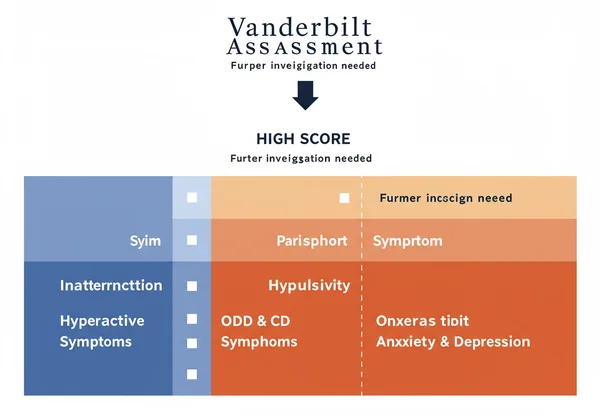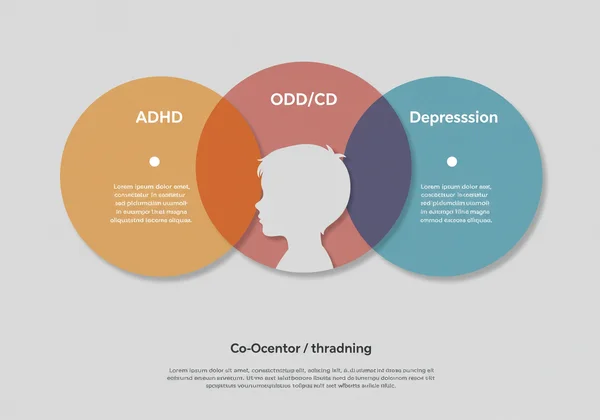การประเมิน Vanderbilt ของบุตรหลานของฉัน: การตีความผลลัพธ์และขั้นตอนต่อไป
การค้นพบผลการประเมิน Vanderbilt ของบุตรหลานของคุณอาจทำให้รู้สึกท่วมท้น ทำให้เกิดความโล่งใจ ความสับสน หรือแม้กระทั่งความกังวล คุณไม่ได้อยู่คนเดียว คู่มือนี้มีจุดมุ่งหมายเพื่อชี้แจงว่าคะแนนเหล่านั้นหมายถึงอะไร และจัดเตรียมขั้นตอนที่สามารถนำไปปฏิบัติได้เพื่อสนับสนุนบุตรหลานของคุณ ขณะที่คุณอ่าน คุณอาจกำลังถามว่า "คะแนน Vanderbilt ที่สูงหมายถึงอะไร?" โปรดจำไว้ว่าการประเมินนี้เป็นเครื่องมือคัดกรองที่มีประสิทธิภาพ ไม่ใช่การวินิจฉัยขั้นสุดท้าย แต่เป็นขั้นตอนแรกที่สำคัญในการทำความเข้าใจรูปแบบพฤติกรรมที่เป็นเอกลักษณ์ของบุตรหลานของคุณ
ข้อมูลที่คุณได้รับเป็นก้าวแรกสู่ความชัดเจนและการสนับสนุนที่มีประสิทธิภาพ เป้าหมายไม่ใช่การติดป้าย แต่คือการทำความเข้าใจและช่วยเหลือบุตรหลานของคุณให้ประสบความสำเร็จ หากคุณยังไม่ได้ทำการประเมิน คุณสามารถ เริ่มการประเมินฟรี บนแพลตฟอร์มที่ปลอดภัยของเราเพื่อรับผลลัพธ์อัตโนมัติทันที คู่มือนี้จะช่วยให้คุณเข้าใจรายงานนั้นและรู้สึกมีกำลังใจเกี่ยวกับสิ่งที่ต้องทำต่อไป

ทำความเข้าใจผลการประเมิน Vanderbilt ของบุตรหลานของคุณ
รายงานการประเมิน Vanderbilt ให้ภาพรวมที่มีโครงสร้างเกี่ยวกับพฤติกรรมของบุตรหลานของคุณตามที่สังเกตโดยคุณหรือครู ไม่ใช่เพียงคะแนนเดียว แต่เป็นภาพรวมของหลายๆ ด้านที่สำคัญ รายงานจากเครื่องมือ online vanderbilt assessment ได้รับการออกแบบมาให้ชัดเจน แต่การทำความเข้าใจองค์ประกอบต่างๆ เป็นหัวใจสำคัญของการนำข้อมูลไปใช้ให้เกิดประโยชน์สูงสุด มาตราส่วน NICHQ Vanderbilt Assessment เป็นที่ไว้วางใจของผู้เชี่ยวชาญด้านกุมารเวชศาสตร์และนักจิตวิทยาด้วยเหตุผลนี้เอง ซึ่งให้มุมมองโดยละเอียดและหลากหลายมิติ
การแบ่งรายงานออกเป็นส่วนๆ ช่วยไขความกระจ่างของตัวเลขและเปอร์เซ็นต์ ลองนึกภาพว่าเป็นแผนที่ที่เน้นพื้นที่ที่บุตรหลานของคุณอาจต้องการการสนับสนุนเพิ่มเติม มันชี้ทิศทางที่ถูกต้อง ให้พื้นฐานที่มั่นคงสำหรับการสนทนากับผู้เชี่ยวชาญที่จะช่วยนำทางไปข้างหน้า
การถอดรหัสแต่ละส่วนของมาตราส่วน
การประเมิน Vanderbilt มาตรฐาน ทั้งในแบบฟอร์มสำหรับผู้ปกครองและครู จะประเมินหลายๆ ด้าน การทำความเข้าใจคะแนนในส่วนเหล่านี้จะทำให้คุณเห็นภาพรวมที่สมบูรณ์ รายงานมักจะแบ่งออกเป็นดังนี้:
- อาการขาดสมาธิ: ส่วนนี้จะประเมินพฤติกรรมต่างๆ เช่น ความยากลำบากในการจดจ่อกับสิ่งที่ทำ การทำผิดพลาดโดยไม่ระวัง การเสียสมาธิได้ง่าย หรือความยากลำบากในการจัดระเบียบ
- อาการอยู่ไม่สุข/หุนหันพลันแล่น: ในส่วนนี้ จะมุ่งเน้นไปที่พฤติกรรมต่างๆ เช่น การนั่งไม่ติดที่ การลุกจากที่นั่ง การพูดมากเกินไป การขัดจังหวะผู้อื่น หรือความยากลำบากในการรอคอย การได้คะแนนสูงในสองส่วนแรกนี้เป็นตัวบ่งชี้หลักสำหรับการคัดกรอง ADHD ที่อาจเกิดขึ้น
- โรคต่อต้านสังคม (ODD) และโรคพฤติกรรม (CD): มาตราส่วนนี้ยังคัดกรองพฤติกรรมที่เกี่ยวข้องกับ ODD (เช่น การโต้เถียงกับผู้ใหญ่ การจงใจรบกวนผู้อื่น การกล่าวโทษผู้อื่น) และ CD (เช่น พฤติกรรมที่ละเมิดกฎอย่างรุนแรง)
- ความวิตกกังวลและภาวะซึมเศร้า: ส่วนนี้จะมองหาสัญญาณต่างๆ เช่น ความกังวลที่มากเกินไป ความหวาดกลัว ความเศร้า หรือการสูญเสียความสนใจในกิจกรรมต่างๆ ซึ่งเป็นสิ่งสำคัญในการระบุภาวะที่เกิดขึ้นร่วมกันบ่อยๆ
แต่ละรายการจะได้รับคะแนนตามความถี่ ตั้งแต่ "ไม่เคย" ไปจนถึง "บ่อยมาก" เครื่องมืออัตโนมัติเช่นของเราจะทำให้ง่ายขึ้นโดยการให้สรุปที่ชัดเจนและระบุพื้นที่ที่น่ากังวลตามเกณฑ์ทางคลินิกที่กำหนดไว้
สิ่งที่ "คะแนน Vanderbilt สูง" อาจบ่งชี้
การเห็นคะแนน Vanderbilt สูงอาจทำให้ตกใจได้ แต่สิ่งสำคัญคือต้องพิจารณาในบริบทที่ถูกต้อง คะแนนที่สูง หรือการมีรายการหลายรายการที่ถูกทำเครื่องหมายว่า "บ่อย" หรือ "บ่อยมาก" ในส่วนที่สำคัญ บ่งชี้ว่าพฤติกรรมของบุตรหลานของคุณมีความสำคัญเพียงพอที่จะต้องมีการตรวจสอบเพิ่มเติม มันบ่งชี้ว่าบุตรหลานของคุณ "มีความเสี่ยง" ต่อ ADHD หรือภาวะอื่น ๆ ที่มาตราส่วนนี้คัดกรอง
มันไม่ใช่การวินิจฉัย แต่เป็นข้อมูลสำคัญที่บ่งชี้ถึงความจำเป็นในการประเมินโดยผู้เชี่ยวชาญ ปัจจัยต่างๆ เช่น สภาพแวดล้อมของบุตรหลาน การเปลี่ยนแปลงชีวิตล่าสุด หรือปัญหาสุขภาพอื่นๆ ก็สามารถส่งผลต่อพฤติกรรมได้เช่นกัน คะแนนเป็นสัญญาณให้คุณรวบรวมข้อมูลเพิ่มเติมและขอคำแนะนำจากผู้เชี่ยวชาญ ซึ่งเป็นขั้นตอนเชิงรุกและเชิงบวก เครื่องมือ ADHD screening tool ของเราได้รับการออกแบบมาเพื่อให้เป็นสัญญาณเตือนแรกที่เชื่อถือได้

ขั้นตอนสำคัญต่อไปหลังการประเมินบุตรหลานของคุณ
รายงานนี้เป็นจุดเริ่มต้นใหม่ เปลี่ยนข้อมูลเชิงลึกเบื้องต้นให้เป็นการดำเนินการที่มีความหมาย ด้วย vanderbilt assessment results ของบุตรหลานของคุณที่พร้อมใช้งาน คุณมีอำนาจในการสนับสนุนความต้องการของพวกเขาอย่างมีประสิทธิภาพ
ขั้นตอนต่อไปนี้ออกแบบมาเพื่อช่วยคุณสร้างระบบสนับสนุนบุตรหลานของคุณ โดยเกี่ยวข้องกับผู้เชี่ยวชาญด้านสุขภาพ นักการศึกษา และการใช้ประโยชน์จากเครื่องมือขั้นสูงเพื่อทำความเข้าใจให้ลึกซึ้งยิ่งขึ้น แต่ละขั้นตอนสร้างต่อจากขั้นตอนก่อนหน้า สร้างกลยุทธ์การสนับสนุนที่ครอบคลุมซึ่งปรับให้เหมาะกับความต้องการของบุตรหลานของคุณ
การเตรียมตัวสำหรับการพูดคุยกับผู้เชี่ยวชาญด้านสุขภาพของคุณ
ขั้นตอนต่อไปที่สำคัญที่สุดของคุณคือการนัดหมายกับกุมารแพทย์ นักจิตวิทยาเด็ก หรือผู้เชี่ยวชาญด้านพัฒนาการ การพูดคุยกับแพทย์เกี่ยวกับ ADHD จะมีประสิทธิภาพมากขึ้นเมื่อคุณเตรียมตัวไปพร้อม การนำสำเนารายงานการประเมิน Vanderbilt ไปด้วย
นี่คือวิธีเตรียมตัว:
- ระบุตัวอย่างเฉพาะเจาะจง: ควบคู่ไปกับรายงาน ให้จดตัวอย่างพฤติกรรมที่น่ากังวล 3-5 อย่างล่าสุด เช่น แทนที่จะพูดว่า "เขาไม่มีระเบียบ" ให้พูดว่า "เขาทำหายโฟลเดอร์การบ้านไปสามครั้งในเดือนนี้และหาไม่เจอรองเท้าเกือบทุกเช้า"
- รวมข้อมูลผลกระทบต่อประสิทธิภาพ: การประเมินถามว่าพฤติกรรมเหล่านี้ส่งผลต่อการเรียน เพื่อน และชีวิตครอบครัวอย่างไร เตรียมพร้อมที่จะพูดคุยในรายละเอียด
- นำรายงานโรงเรียนไปด้วย: หากคุณมี
vanderbilt assessment teacher formหรือบันทึกใดๆ จากครูของบุตรหลานของคุณ ให้นำไปด้วย มุมมองที่หลากหลายมีคุณค่าอย่างยิ่ง
สำรวจคุณค่าของรายงาน AI ที่ปรับให้เหมาะกับบุคคล
แม้ว่ารายงานมาตรฐานจะบอกคุณว่ามีพฤติกรรม อะไร บ้าง แต่ก็ไม่ได้อธิบาย เหตุใด หรือเชื่อมโยงกับสถานการณ์ชีวิตเฉพาะของบุตรหลานของคุณอย่างไร นี่คือที่ที่เทคโนโลยีสามารถให้ข้อมูลเชิงลึกที่ลึกซึ้งยิ่งขึ้น แพลตฟอร์มของเรามีรายงาน AI ที่ปรับให้เหมาะกับบุคคล ซึ่งเป็นทางเลือกที่นอกเหนือไปจากการให้คะแนนมาตรฐาน
รายงานขั้นสูงนี้จะวิเคราะห์คำตอบของคุณในบริบทของข้อมูลเพิ่มเติมที่คุณให้เกี่ยวกับชีวิตประจำวัน จุดแข็ง และความท้าทายของบุตรหลานของคุณ มันสามารถสร้างสถานการณ์ที่ปรับให้เหมาะกับบุคคล ระบุตัวกระตุ้นที่เป็นไปได้สำหรับพฤติกรรมบางอย่าง และเสนอ กลยุทธ์ที่ปรับให้เหมาะกับบุคคลที่ไม่ใช่ทางการแพทย์เพื่อลองที่บ้านและที่โรงเรียน การวิเคราะห์โดยละเอียดนี้จะเป็นเครื่องมือที่มีค่าอย่างยิ่งเมื่อคุณ พูดคุยผลลัพธ์กับผู้เชี่ยวชาญ ซึ่งจะทำให้คุณและแพทย์ของคุณมีภาพที่สมบูรณ์และละเอียดอ่อนยิ่งขึ้นเกี่ยวกับบุตรหลานของคุณ

การร่วมมือกับโรงเรียนของบุตรหลานของคุณเพื่อรับการสนับสนุน
โรงเรียนของบุตรหลานของคุณเป็นพันธมิตรที่สำคัญ เปิดช่องทางการสื่อสารกับครูที่ปรึกษาของบุตรหลาน หรือผู้ประสานงานการศึกษาพิเศษ แบ่งปันความกังวลของคุณ และหากคุณรู้สึกสบายใจ ก็แบ่งปันข้อมูลเชิงลึกจากการประเมิน Vanderbilt คุณสามารถขอให้ครู กรอก vanderbilt assessment teacher form เพื่อให้มุมมองของพวกเขา
ความร่วมมือสามารถนำไปสู่การปรับเปลี่ยนในห้องเรียนที่เรียบง่ายแต่มีประสิทธิภาพ สิ่งเหล่านี้อาจรวมถึงการจัดที่นั่งที่เอื้อต่อสมาธิเพื่อลดสิ่งรบกวน การแบ่งงานใหญ่ออกเป็นขั้นตอนเล็กๆ หรือการจัดหาพื้นที่เงียบสงบสำหรับการทำงานที่ต้องใช้สมาธิ การเป็นพันธมิตรระหว่างบ้านและโรงเรียนที่ร่วมมือกันจะช่วยให้บุตรหลานของคุณได้รับการสนับสนุนที่สอดคล้องกันในสภาพแวดล้อมที่สำคัญที่สุดของพวกเขา
การรับรู้ภาวะอื่นๆ ที่ Vanderbilt คัดกรอง
จุดแข็งที่ยิ่งใหญ่ที่สุดประการหนึ่งของการประเมิน Vanderbilt คือขอบเขตที่ครอบคลุมสำหรับการคัดกรองภาวะต่างๆ ADHD แทบไม่เคยเกิดขึ้นโดยลำพัง เด็กที่มี ADHD มักประสบกับความท้าทายกับภาวะทางพฤติกรรมหรืออารมณ์อื่นๆ และเครื่องมือนี้ได้รับการออกแบบมาเพื่อช่วยระบุภาวะเหล่านี้ตั้งแต่เนิ่นๆ
การทำความเข้าใจสิ่งนี้ช่วยให้ผู้ปกครองตระหนักว่าความยากลำบากของบุตรหลานอาจซับซ้อนกว่าแค่การขาดสมาธิหรืออยู่ไม่สุข เปิดประตูสู่กลยุทธ์การสนับสนุนที่ตรงเป้าหมายและมีประสิทธิภาพมากขึ้น ซึ่งจัดการกับบุตรหลานทั้งคน ไม่ใช่แค่ชุดอาการเดียว
การทำความเข้าใจพฤติกรรมและภาวะที่เกิดขึ้นร่วมกัน
ส่วนที่เกี่ยวกับ ODD, CD, ความวิตกกังวล และภาวะซึมเศร้ามีความสำคัญอย่างยิ่ง ภาวะที่เกิดขึ้นร่วมกับ ADHD นั้นพบได้บ่อย และการจัดการกับสิ่งเหล่านี้เป็นสิ่งสำคัญต่อความเป็นอยู่ที่ดีโดยรวมของบุตรหลานของคุณ ตัวอย่างเช่น เด็กอาจแสดงพฤติกรรมที่ก้าวร้าว (ODD) เนื่องมาจากความหงุดหงิดและความภาคภูมิใจในตนเองต่ำที่เกิดจากความยากลำบากในการเรียน (ADHD) หรือพวกเขาอาจรู้สึกกังวลอย่างต่อเนื่อง (ความวิตกกังวล) เกี่ยวกับผลการเรียนหรือผลการเรียนทางสังคม
รายงานการประเมิน Vanderbilt ให้ข้อมูลแก่คุณและผู้ให้บริการด้านสุขภาพของคุณเกี่ยวกับความทับซ้อนที่อาจเกิดขึ้น สิ่งนี้ช่วยให้สามารถประเมินวินิจฉัยที่ครอบคลุมมากขึ้น และแผนการรักษาที่ตอบสนองความต้องการทั้งหมดของบุตรหลานของคุณ นำไปสู่ผลลัพธ์ที่ดีขึ้น และบุตรหลานที่มีความสุขและมั่นใจมากขึ้น

การดำเนินการ: เส้นทางข้างหน้าสำหรับบุตรหลานของคุณหลังการประเมิน Vanderbilt
การทำความเข้าใจผลการประเมิน Vanderbilt ของบุตรหลานของคุณเป็นขั้นตอนสำคัญ คุณได้รับข้อมูลเชิงลึกที่มีคุณค่า เปลี่ยนจากความไม่แน่นอนไปสู่เส้นทางที่ชัดเจนสำหรับการดำเนินการ คะแนนเหล่านี้ไม่ใช่ป้ายชื่อ แต่เป็นแนวทางที่จำเป็น ชี้ให้คุณเห็นถึงการสนับสนุนที่มีประสิทธิภาพที่สุด การเดินทางครั้งนี้คือความร่วมมือ ซึ่งเกี่ยวข้องกับคุณ บุตรหลานของคุณ ผู้เชี่ยวชาญด้านสุขภาพ และโรงเรียนของพวกเขา ในฐานะผู้สนับสนุนที่แข็งแกร่งที่สุดของคุณ ตอนนี้คุณมีเครื่องมือจากการประเมินนี้เพื่อสร้างรากฐานที่มั่นคงสำหรับการเติบโตของพวกเขา
เราขอแนะนำให้คุณใช้ความรู้นี้เพื่อเริ่มการสนทนาที่มีประสิทธิผลและสำรวจแหล่งข้อมูลทั้งหมดที่มี สำหรับขั้นตอนแรกที่น่าเชื่อถือและเป็นส่วนตัว ทำการประเมิน วันนี้
คำถามที่พบบ่อยเกี่ยวกับผลการประเมิน Vanderbilt
การประเมิน ADHD ของ Vanderbilt ถูกต้องหรือไม่?
การประเมิน ADHD ของ Vanderbilt ถือเป็นเครื่องมือคัดกรองที่มีความน่าเชื่อถือและมีความเที่ยงตรงสูงเมื่อใช้ได้อย่างถูกต้อง ความแม่นยำมาจากการได้รับการพัฒนาโดย NICHQ และได้รับการรับรองจาก American Academy of Pediatrics อย่างไรก็ตาม ความแม่นยำขึ้นอยู่กับคำตอบที่ซื่อสัตย์และรอบคอบจากผู้ที่ทำการประเมิน มันเป็นเครื่องมือคัดกรอง ไม่ใช่การทดสอบเพื่อการวินิจฉัย ซึ่งหมายความว่ามันสามารถระบุเด็ก ที่มีความเสี่ยง ที่ต้องการการประเมินเพิ่มเติมโดยผู้เชี่ยวชาญที่มีคุณสมบัติเหมาะสมได้อย่างถูกต้อง
คะแนน Vanderbilt สูงหมายถึงอะไร?
คะแนน Vanderbilt สูงหมายความว่าบุตรหลานของคุณแสดงพฤติกรรมที่เกี่ยวข้องกับ ADHD หรือภาวะอื่นๆ ที่ถูกคัดกรอง (เช่น ODD หรือความวิตกกังวล) เป็นจำนวนมาก ซึ่งส่งผลกระทบต่อการดำเนินชีวิตประจำวันของพวกเขา เป็นสัญญาณที่ชัดเจนว่าจำเป็นต้องมีการประเมินอย่างเป็นทางการโดยผู้เชี่ยวชาญ ไม่ได้หมายถึงการวินิจฉัยโดยอัตโนมัติ แต่เป็นข้อมูลสำคัญที่จำเป็นในการเริ่มต้นการสนทนาที่มีประสิทธิผลกับผู้ให้บริการด้านสุขภาพ คุณสามารถ รับผลลัพธ์ของคุณ ได้ทันทีบนแพลตฟอร์มของเราเพื่อดูว่าบุตรหลานของคุณอยู่ที่จุดใด
สามารถใช้การประเมิน Vanderbilt กับผู้ใหญ่ได้หรือไม่?
ไม่ มาตราส่วนการประเมิน Vanderbilt ได้รับการออกแบบ ตรวจสอบความถูกต้อง และกำหนดมาตรฐานสำหรับเด็กอายุ 6 ถึง 12 ปีโดยเฉพาะ ไม่เหมาะสำหรับการประเมิน ADHD ในวัยรุ่นหรือผู้ใหญ่ มีมาตราส่วนการให้คะแนนและเครื่องมือการวินิจฉัยอื่นๆ เช่น ASRS (Adult ADHD Self-Report Scale) ที่ออกแบบมาเพื่อประเมินอาการ ADHD ในผู้ใหญ่
การประเมิน Vanderbilt คัดกรองภาวะใดบ้าง?
การประเมิน Vanderbilt คัดกรองมากกว่าแค่ ADHD หน้าที่หลักคือการคัดกรองทั้งชนิดที่ขาดสมาธิและชนิดที่อยู่ไม่สุข/หุนหันพลันแล่นของ ADHD นอกจากนี้ ยังมีส่วนการคัดกรองสำหรับภาวะที่เกิดขึ้นร่วมกันบ่อยๆ ซึ่งรวมถึงโรคต่อต้านสังคม (ODD) โรคพฤติกรรม (CD) และความวิตกกังวลและภาวะซึมเศร้า ทำให้เป็น adhd screening tool เบื้องต้นที่ครอบคลุม
วิธีให้คะแนนการประเมิน Vanderbilt?
การให้คะแนนการประเมิน Vanderbilt คือการนับจำนวนคำถามที่ทำเครื่องหมายว่า "บ่อย" หรือ "บ่อยมาก" (คะแนน 2 หรือ 3) ภายในแต่ละหมวดอาการ มีเกณฑ์เฉพาะสำหรับแต่ละหมวด (เช่น 6 จาก 9 สำหรับ ADHD ประเภทขาดสมาธิ) ที่ต้องตรงตาม และส่วนประสิทธิภาพจะต้องแสดงถึงความบกพร่องด้วย เครื่องมือ online Vanderbilt Assessment ของเราทำให้กระบวนการทั้งหมดนี้เป็นอัตโนมัติ ขจัดข้อผิดพลาดจากการคำนวณด้วยตนเอง และจัดทำรายงานที่อ่านง่ายทันที